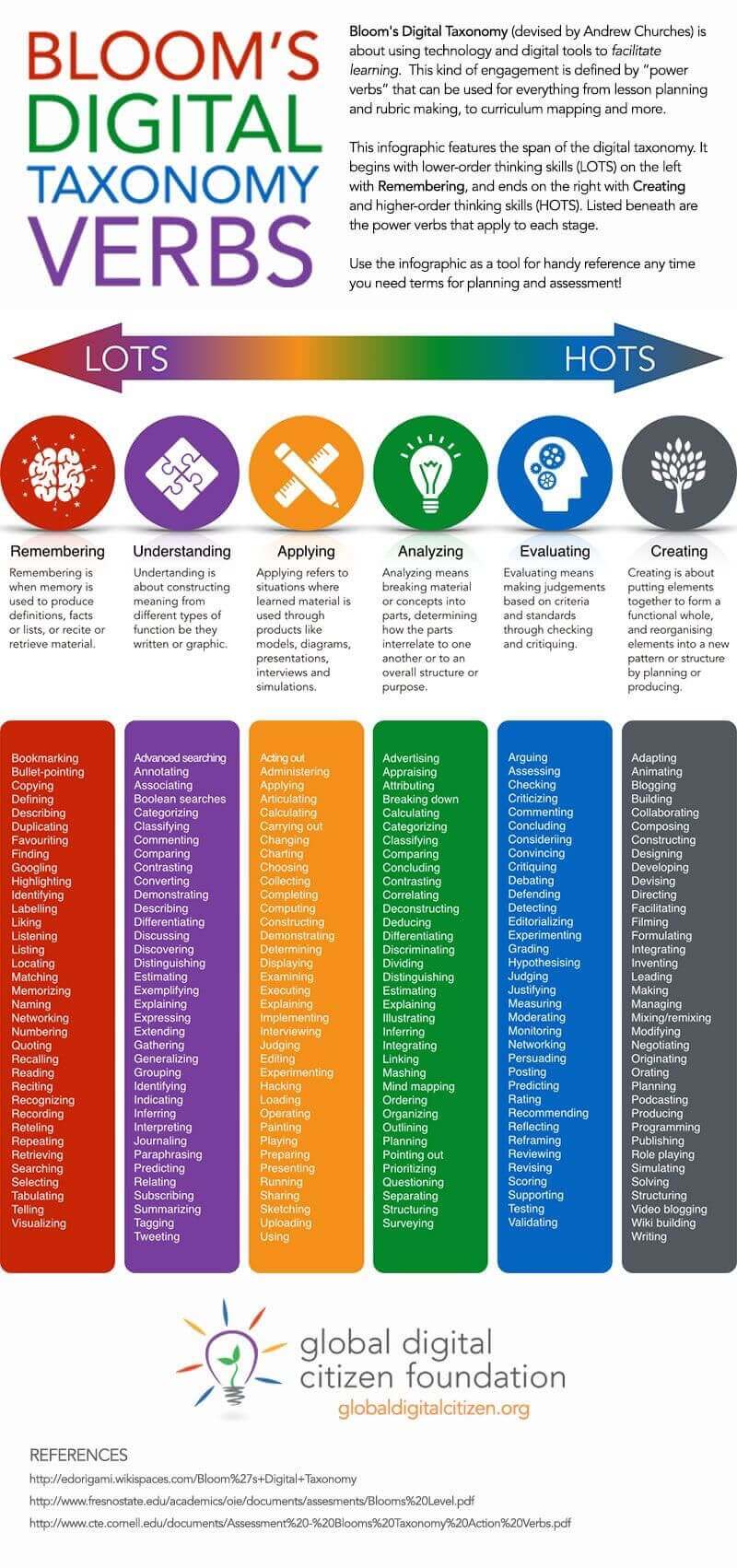by Staff
At Teachthought, we are enthusiastic supporters of any learning taxonomy. (We have even created ours, the Teaching learning taxonomy.)
In simple terms, learning taxonomies helps us to think about how learning occurs. Even if they are not “good”, because we have often seen the Dok framework describes, they always emphasize that there are many ways to frame thought and practice us to achieve this potential.
Bloom’s digital taxonomy verbs adapt Bloom’s original cognitive framework for digital learning, helping teachers from kindergarten to 12th year to integrate technology while strengthening reflection skills. Taxonomy organizes digital levels in levels such as recall, understanding, application, analysis, evaluation and creation, each with technological verbs that support specific learning objectives.
This means that we can have taxonomies for differentiation and taxonomies for thought and taxonomies for tasks and evaluation – so many possibilities to examine the real process of thinking, learning and application of each.
This leads to cool visuals –Bloom taxonomy postersFor example.
It can also lead to tools that help design lessons, units and evaluations –Bloom taxonomy verbs Works well here.
You can get a ready version for Bloom digital taxonomy for $ 6.95.

And this can lead to a new burst of the concept, such as this graph which merges the learning of the 21st century, modern digital and social spaces, and bloom taxonomy in a frame. This teacher graph provides 126 power verbs for digital learning – a kind of bloom Digital The taxonomy based on existing memory, to be understood – Apply – Analyze -Evaluate – Creation, then provides common digital tasks such as moderation, duplication, blogs, construction of wiki, podcasting, etc.
The result is a tool that can help teachers think about higher order reflection levels that enter into this type of activities and projects. To be clear, it is not because a verb is in a category that it cannot be used at higher or lower levels of thinking (that is to say, appear in other categories of Bloom digital taxonomy).
Are you looking for a traditional version of Bloom verbs? Consult the taxonomy verbs of our flowering for teaching and planning.
Do you want to see how these verbs are visually aligning with levels of reflection? Explore the digital taxonomy table of our flowering.
In fact, there is a significant quantity of subjectivity and writing that goes within any framework that claims to describe how thought occurs. It is not an exact science. Nevertheless, the simple fact that we explore the thoughts and digital tasks and the work of students together is at least as precious as any framework unique in itself.
By doing this kind of work, we, collectively, you, teacher, administrators, schools, researchers, universities, etc. – can develop the “mastery” of the troubled and abstract field of applied neurology. We can start understanding how understanding occurs.
Bloom digital taxonomy power verbs
I hope you will find the useful graphic for exploring, discussing, planning and participating otherwise in Bloom’s digital taxonomy.
You can also find a ready version for the taxonomy class of our flowering verbs and digital planning cards to shorten preparation time and focus on wider lesson and unit planning strategies for your students.
If you have verbs that you want to see added to the graphic, let us know in the comments below.
126 Bloom taxonomy verbs for digital learning
Memory
- Copy
- Decisive
- Finding
- Location
- Quote
- Listen
- Google search
- Repetitive
- Recovery
- Hearing
- Highlighting
- Memorization
- Networking
- Research
- Identifier
- Selection
- Tab
- Duplication
- Appearance
- Conservation and bookmark
- Pointing
Understanding
- Annotating
- Tweet
- Partner
- Taging (marking of your program for example)
- Summary
- Related
- Categorization
- Paraphrasing
- Forecast
- Comparison
- Contrast
- Comment
- Journalization
- Interpretation
- Grouping
- Deducting
- Estimate
- Extension
- Gathering
- Illustrating
- Expressing
Application
- Playing
- Articulate
- Reconstruct
- Loading
- Choice
- Decisive
- Display
- Revision of key research
- Executation
- Examiner
- Execution
- Sketch
- Experimentation
- Piracy
- Interview
- Paint
- Preparation
- Playing
- Integration
- Presentation
- Cartography
Analysis
- Calculator
- Categorize (for example, web content, search results, etc.)
- Decomposition
- Correlation
- Deconstruct
- Strategic hyperization
- Support (for example, a cause)
- Mental cartography
- Organizer
- Assessment
- Advertisement
- Sharing
- Deduction
- Distinguish
- Illustrating
- Examination
- Structuring
- Integration
- Attribution
- Estimate
- Explaining
Assessment
- Argue and debate
- Validation
- Essay
- Notation
- Assessment
- Criticism
- Comment
- Iteration or pivot (for example, startup or application)
- Entirely
- Detection
- Experimentation
- Gradation
- Programs
- Judgement
- Moderator
- Assignment
- Forecast
- Notation
- Thoughtful
- Examination (for example, a service or a platform)
- Editorialization
Creation
- Blogger
- Building
- Lively
- Adaptation
- Collaboration
- Composition
- Direction
- Dedressing
- Podcasting
- Wiki building
- Writing
- Filming
- Programming
- Simulation
- Role -playing
- Resolution
- Remixing
- Facilitation
- Design (a YouTube channel, for example)
- Negotiation
- Leading
Another version of Global Digital Citizen’s graphic appears below.

Teachthought’s mission is to promote critical thinking and innovation education.



